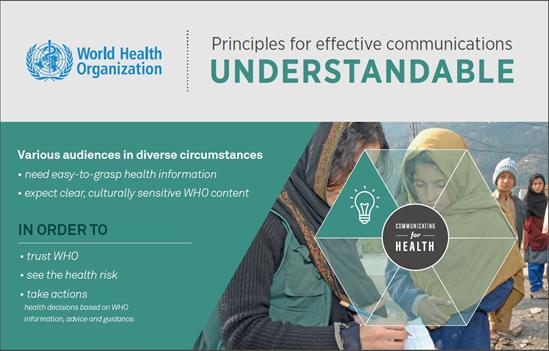
Principle: Understandable
Tell real stories
Tactics to apply to make your communications understandable
Tell real stories
Descriptive storytelling makes health information more understandable and compelling. WHO communicators can use narratives to:
- bring a human face to suffering;
- inspire audiences with success stories that would motivate them to take action;
- tell WHO’s story, about specific teams and activities, showing how WHO protects health and saves lives;
- showcase decision-makers who implemented WHO policies and experienced positive outcomes; and
- build confidence in WHO and its guidance.
Use real stories to help audiences relate to the health information provided
Communicators can connect WHO to real-life situations by developing human interest stories that highlight WHO efforts to improve health.
Photo stories are a good way to make health issues concrete to demonstrate the effects of WHO’s work. To motivate the target audience towards action, communicators should make their products easy to understand by:
- using photo stories that contain action-oriented photographs with captions;
- including compelling, captivating images in photo stories;
- placing photo stories prominently on the website homepage;
- translating text associated with photo stories into all six official languages; and
- directing viewers to WHO programme pages to learn more about the health issues presented in photo stories.
Web feature stories can also help audiences understand how WHO works with national and local health authorities to improve public health. It is often challenging to explain to the public the policy and guidance work that WHO conducts. Illustrated stories make these efforts understandable by showing the effects of WHO policy by:
- describing the experience of someone who has benefited directly from a WHO recommendation, policy or action implemented by a national or local partner;
- focusing on a local health worker who implemented a WHO policy or guidance and achieved positive results; and
- reinforcing the authenticity of a story by including quotes from people highlighted in the narrative.
Include anecdotes in presentations
Including anecdotes in presentations and reports is a good way to make WHO’s work clear and interesting in the eyes of the audience. They provide engaging examples of how WHO’s work benefits people.







